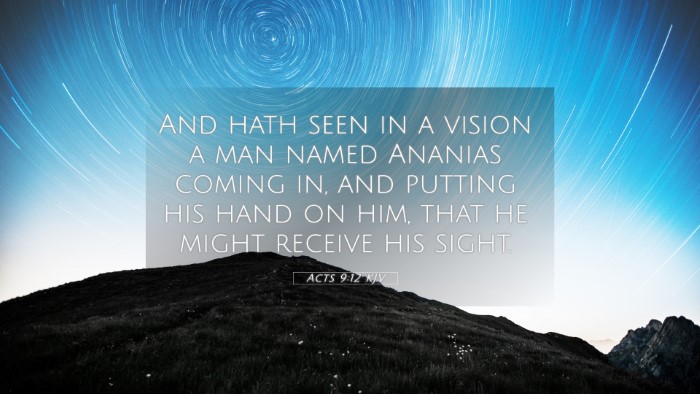Understanding Acts 9:12
Acts 9:12 states, "And hath seen in a vision a man named Ananias coming in, and putting his hand on him, that he might receive his sight." This verse is crucial in understanding the transformative moment in the life of Saul of Tarsus (later known as the Apostle Paul). Below is a summary of insights drawn from public domain commentaries, highlighting the verse's deeper meanings and connections within the Bible.
Verse Context and Significance
This verse occurs in the narrative of Saul's conversion on the road to Damascus. The Lord reveals to Ananias that he is to visit Saul, who has been blinded following his encounter with Jesus. The significance of this verse lies in the divine preparation that underscores the importance of Ananias's obedience and the miraculous nature of Saul's healing.
Commentary Insights
-
Matthew Henry:
Henry emphasizes God's sovereignty in directing the events surrounding Saul's conversion. He notes that Ananias's vision signifies God's providence and the specific instruments He uses for His purposes. By sending Ananias, God illustrates the importance of community and support in spiritual restoration.
-
Albert Barnes:
Barnes points out the significance of the vision, suggesting it illustrates God's direct intervention in human affairs. He explains that Ananias was a disciple who exhibited faith and obedience, serving as a key instrument in introducing Saul to the Christian community and confirming his spiritual transformation.
-
Adam Clarke:
Clarke focuses on the religious implications of Ananias’s mission. He discusses the fear and reluctance that Ananias initially felt, pointing out that his eventual compliance was a profound act of faith. This not only affirms God’s power but also highlights the grace extended to Saul, a former persecutor of Christians.
Cross-References and Thematic Connections
This verse can be linked to several other Bible verses that illuminate its meaning and extend its themes:
- Acts 9:13-14: Ananias expresses his concerns about Saul’s past, highlighting the grace extended to those who may not seem deserving.
- Acts 22:12-16: Saul's baptism and commission reaffirm his transformation, showcasing the theme of redemption.
- 2 Corinthians 5:17: Paul talks about becoming a new creation, which directly connects to his healing and new mission.
- Romans 12:1-2: Paul speaks of transformation through renewal, echoing his experiences in Acts.
- John 9:6-7: Jesus heals a blind man, paralleling the miraculous healing of Saul.
- Isaiah 35:5: References the opening of blind eyes, which can be seen as prophetic foreshadowing of Saul's healing.
- Matthew 28:19-20: The Great Commission reflects God's plan for Saul (Paul) as a key figure in spreading the Gospel to the Gentiles.
Thematic Analysis
The key themes arising from Acts 9:12 include:
- Divine Intervention: Acts 9:12 emphasizes God's direct involvement in human salvation and ministry.
- Transformation: The healing of Saul signifies the transformative power of faith and obedience.
- Community in Faith: Ananias's role highlights the need for community support in spiritual journeys.
Conclusion
Acts 9:12 serves as a pivotal moment in the narrative of the New Testament, illustrating God's will in the redemption of sinners and the establishment of the Church. The connections between this verse and others in Scripture provide a rich tapestry of God’s grace, mercy, and proactive engagement in the lives of His followers. To fully recognize these theological depths, one may engage in tools for Bible cross-referencing, thereby enriching one's understanding of the interconnectedness of Scripture.
Further Study and Resources
For those interested in pursuing more detailed studies in scripture and understanding the connections between verses, consider employing:
- Bible Concordance
- Bible Cross-Reference Guide
- Cross-Reference Bible Study Techniques
- Understanding the Inter-Biblical Dialogue
Empowered with these resources, one can deepen their biblical literacy and appreciation for the intricate connections that bind the Holy Scriptures together.





